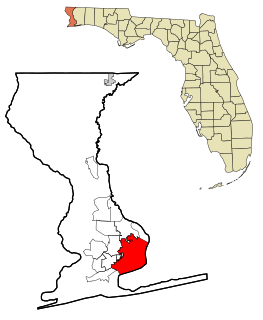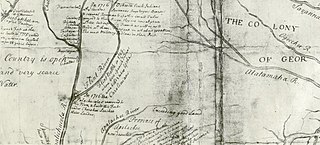
Pensacola is the westernmost city in the Florida Panhandle, approximately 13 miles (21 km) from the border with Alabama, and the county seat of Escambia County, in the U.S. state of Florida. As of the 2010 census, the city had a total population of 51,923, down from 56,255 at the 2000 census. Pensacola is the principal city of the Pensacola metropolitan area, which had an estimated 494,883 residents as of 2018.

Muskogean is a language family spoken in different areas of the Southeastern United States. Though the debate concerning their interrelationships is ongoing, the Muskogean languages are generally divided into two branches, Eastern Muskogean and Western Muskogean. Typologically, Muskogean languages are agglutinative. One documented language, Apalachee, is extinct and the remaining languages are critically endangered.
Tocobaga was the name of a chiefdom, its chief, and its principal town during the 16th century. The chiefdom was centered around the northern end of Old Tampa Bay, the arm of Tampa Bay that extends between the present-day city of Tampa and northern Pinellas County. The exact location of the principal town is believed to be the archeological Safety Harbor Site, which gives its name to the Safety Harbor culture, of which the Tocobaga are the most well-known group.

The Yamasee were a multiethnic confederation of Native Americans who lived in the coastal region of present-day northern coastal Georgia near the Savannah River and later in northeastern Florida.

Spanish Florida was the first major European land claim and attempted settlement in North America during the European Age of Discovery. La Florida formed part of the Captaincy General of Cuba, the Viceroyalty of New Spain, and the Spanish Empire during Spanish colonization of the Americas. While its boundaries were never clearly or formally defined, the territory was much larger than the present-day state of Florida, extending over much of what is now the southeastern United States, including all of present-day Florida plus portions of Georgia, Alabama, Mississippi, North Carolina, South Carolina, and southeastern Louisiana. Spain's claim to this vast area was based on several wide-ranging expeditions mounted during the 16th century. A number of missions, settlements, and small forts existed in the 16th and to a lesser extent in the 17th century; eventually they were abandoned due to pressure from the expanding English and French colonial projects, the collapse of the native populations, and the general difficulty in becoming agriculturally or economically self-sufficient. By the 18th century, Spain's control over La Florida did not extend much beyond its forts, all located in present-day Florida: near St. Augustine, St. Marks, and Pensacola.
The History of Leon County, Florida is a varied history of human habitation extending from 12,000 years ago to present. This includes Paleoindians, the Apalachee, the Seminole Indians, the British, Spanish, colonial Americans, and slaves.
Guale was a historic Native American chiefdom of Mississippian culture peoples located along the coast of present-day Georgia and the Sea Islands. Spanish Florida established its Roman Catholic missionary system in the chiefdom in the late 16th century.

The Apalachee massacre was a series of raids by English colonists from the Province of Carolina and their Indian allies against a largely peaceful population of Apalachee Indians in northern Spanish Florida that took place in 1704, during Queen Anne's War. Against limited Spanish and Indian resistance, a network of missions was destroyed; most of the population either was killed or captured, fled to larger Spanish and French outposts, or voluntarily joined the English.

Escambe was a Spanish Franciscan mission built in the 17th century in the Florida Panhandle, three miles northwest of the present-day town of Tallahassee, Florida. It was part of Spain's effort to colonize the region, and convert the Timucuan and Apalachee Indians to Christianity. The mission lasted until 1704, when it was destroyed by a group of Creek Indians and South Carolinians.
The history of Pensacola, Florida, begins long before the Spanish claimed founding of the modern city in 1698. The area around present-day Pensacola was inhabited by Native American peoples thousands of years before the historical era.

Beginning in the second half of the 16th century, the Kingdom of Spain established a number of missions throughout La Florida in order to convert the Indians to Christianity, to facilitate control of the area, and to prevent its colonization by other countries, in particular, England and France. Spanish Florida originally included much of what is now the Southeastern United States, although Spain never exercised long-term effective control over more than the northern part of what is now the State of Florida from present-day St. Augustine to the area around Tallahassee, southeastern Georgia, and some coastal settlements, such as Pensacola, Florida. A few short-lived missions were established in other locations, including Mission Santa Elena in present-day South Carolina, around the Florida peninsula, and in the interior of Georgia and Alabama.
The indigenous peoples of Florida lived in what is now known as Florida for more than 12,000 years before the time of first contact with Europeans. However, the indigenous Floridians have largely died out with some completely by the early 18th century. Some Apalachees migrated to Louisiana, where their descendants now live, some were taken to Cuba and Mexico by the Spanish in the 18th century, and a few may have been absorbed into the Seminole and Miccosukee tribes.

Antonio Benavides Bazán y Molina was a Lieutenant General in the Spanish Army who held administrative positions in the Americas as Royal Governor of Spanish Florida (1718–1734), Governor of Veracruz (1734–1745), Governor and Captain General of Yucatán province, as well as Governor of Manila in the Philippines. Before his successive appointments to these various positions, he served with distinction in several campaigns of the War of the Spanish Succession in 1710, and perhaps saved the life of Philip V, the first Bourbon King of Spain, at Guadalajara.

The Battle of Flint River was a failed attack by Spanish and Apalachee Indian forces against Creek Indians in October 1702 in what is now the state of Georgia. The battle was a major element in ongoing frontier hostilities between English traders from the Province of Carolina and Spanish Florida, and it was a prelude to more organized military actions of Queen Anne's War.

The Siege of Pensacola was two separate attempts in 1707 by English-supported Creek Indians to capture the town and fortress of Pensacola, one of two major settlements in Spanish Florida.
The Pensacola were a Native American people who lived in the western part of what is now the Florida Panhandle and eastern Alabama for centuries before first contact with Europeans until early in the 18th century. They spoke a Muskogean language. They are the source of the name of Pensacola Bay and the city of Pensacola. They lived in the area until the mid-18th century, but were thereafter assimilated into other groups.

Spanish West Florida was a province of the Spanish Empire from 1783 until 1821, when both it and East Florida were ceded to the United States.
The Chato were an indigenous people of the Southeastern Woodlands, that formerly lived on the coast in Mississippi and Alabama and around Mobile Bay. They were related to the Choctaws and Chickasaws. One source indicates that "The Chato were part of the Apalachee Indian tribe, as were the Escambe." However, the more general opinion is that the Chato tribe was of unknown ethnic affinity, although they were allied with the Choctaw.

Ocute, later known as Altamaha or La Tama and sometimes known conventionally as the Oconee province, was a Native American paramount chiefdom in the Piedmont region of the U.S. state of Georgia in the 16th and 17th centuries. Centered in the Oconee River valley, the main chiefdom of Ocute held sway over the nearby chiefdoms of Altamaha, Cofaqui, and possibly others.
















